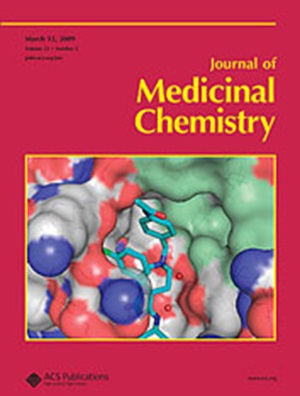Discovery of Potent Acyl-CoA Synthetase Long-Chain Family Member 4 (ACSL4) Inhibitors with Antiferroptotic Properties.
IF 6.8
1区 医学
Q1 CHEMISTRY, MEDICINAL
引用次数: 0
Abstract
Ferroptosis, an iron-dependent regulated cell death, is implicated in several diseases, including cancer and neurodegeneration. While most ferroptosis inhibitors act as radical-trapping antioxidants, direct modulation of pro-ferroptotic enzymes remains underexplored. Acyl-coenzyme A synthetase long-chain family member 4 (ACSL4), a key regulator of ferroptosis, has emerged as a promising therapeutic target. Here, we report a fragment-based screening that identified a benzofuran hit (compound 8, IC50 = 33 μM), leading to the discovery of two selective ACSL4 inhibitors: compound 15b (LIBX-A402, IC50 = 0.33 μM) and compound 21 (LIBX-A403, IC50 = 0.049 μM). Compound 21 is the most potent ACSL4 inhibitor reported to date and shows no activity against ACSL3. Molecular modeling and mutagenesis support its binding in the ACSL4 fatty acid pocket. The strong antiferroptotic activity of both compounds in cells, together with confirmed target engagement for 21, underscores the relevance of ACSL4 as a target for ferroptosis modulation.强效酰基辅酶a合成酶长链家族成员4 (ACSL4)抑制剂的发现。
铁下垂是一种铁依赖性调节的细胞死亡,涉及多种疾病,包括癌症和神经变性。虽然大多数铁衰亡抑制剂作为自由基捕获抗氧化剂,直接调节前铁衰亡酶仍未被充分探索。酰基辅酶A合成酶长链家族成员4 (ACSL4)是铁下垂的关键调节因子,已成为一个有希望的治疗靶点。在这里,我们报道了基于片段的筛选,发现了一个苯并呋啶命中(化合物8,IC50 = 33 μM),从而发现了两个选择性ACSL4抑制剂:化合物15b (LIBX-A402, IC50 = 0.33 μM)和化合物21 (LIBX-A403, IC50 = 0.049 μM)。化合物21是迄今为止报道的最有效的ACSL4抑制剂,对ACSL3没有活性。分子模拟和诱变支持其在ACSL4脂肪酸口袋中的结合。这两种化合物在细胞中具有很强的抗铁衰亡活性,加上已确认的靶向作用,强调了ACSL4作为铁衰亡调节靶点的相关性。
本文章由计算机程序翻译,如有差异,请以英文原文为准。
求助全文
约1分钟内获得全文
求助全文
来源期刊

Journal of Medicinal Chemistry
医学-医药化学
CiteScore
4.00
自引率
11.00%
发文量
804
审稿时长
1.9 months
期刊介绍:
The Journal of Medicinal Chemistry is a prestigious biweekly peer-reviewed publication that focuses on the multifaceted field of medicinal chemistry. Since its inception in 1959 as the Journal of Medicinal and Pharmaceutical Chemistry, it has evolved to become a cornerstone in the dissemination of research findings related to the design, synthesis, and development of therapeutic agents.
The Journal of Medicinal Chemistry is recognized for its significant impact in the scientific community, as evidenced by its 2022 impact factor of 7.3. This metric reflects the journal's influence and the importance of its content in shaping the future of drug discovery and development. The journal serves as a vital resource for chemists, pharmacologists, and other researchers interested in the molecular mechanisms of drug action and the optimization of therapeutic compounds.
 求助内容:
求助内容: 应助结果提醒方式:
应助结果提醒方式:


